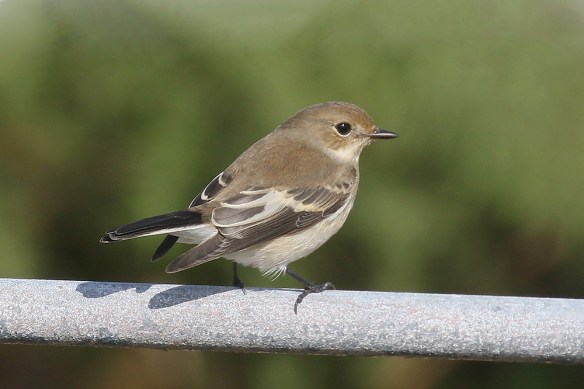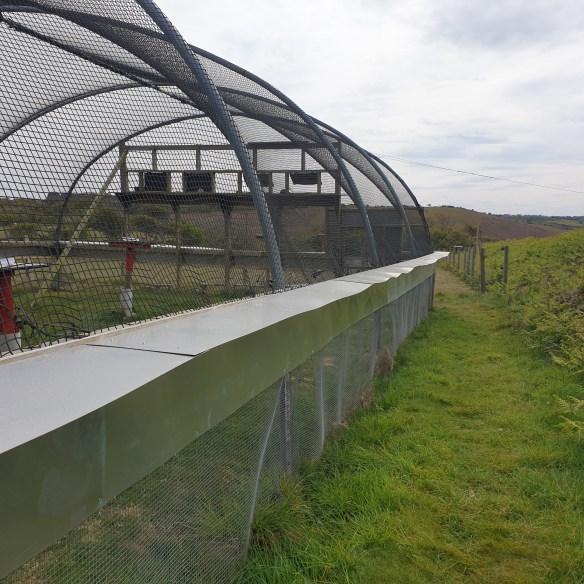By Liz Corry
Plémont success
Last month we reported our first successful rearing of young from a wild-hatched pair. Three chicks in the Plémont nest followed by the subsequent fledging of two.
Then, like a high street in lockdown, it went eerily quiet.
There was no sign of the third chick out and about. The Plémont cliffs are not very forgiving at high tide for a young bouldering chough. Easy to imagine it not surviving. Yet also hard to determine since we weren’t seeing any members of the Plémont family.
When Minty and Rey, the parents, eventually appeared at the feed they showed no interest in any of the juveniles. Observations were further hampered by the lack of choughs at the feed. We had to put in the extra mileage, literally, to travel in search of choughs or wait until the evening when they start heading home to roost.
A roost check at Plémont provided no answers just a stunning sunset.
The only info we had was from a member of the public who had photographed Minty and Rey with one unringed juvenile at the Pinnacle on the northwest coast. This was taken in June before we had managed to ring any of this year’s young.
Four weeks of not knowing then suddenly we had our answer. Reviews of camera trap photos set at the aviary showed Minty passing food to a chick. A chick we had ringed on 14th July and had seen at the feed every day since! Until that last week in July we had never witnessed Minty or Rey show any interest in the youngster.
Maybe that is their parenting style? The young chough is fairly robust, gets on with things, is confident around the aviary and within the flock. They raised her well.
We have named her Rémi which means ‘the first ones’ in Gaulish. Rather apt for the first true Jersey chough resulting from the reintroduction.
Five ‘gold’ rings
With much effort, we continued to try and trap unringed juveniles in the aviary. As already mentioned, the birds were not hanging around Sorel as much as in previous years. Leftover supplemental food and their preference of sites such as Grosnez, Les Landes, and L’Étacq implied they had resources elsewhere.
When choughs were present at the aviary they were, and still are, not as confident about going inside. No doubt for multiple reasons although strong influences will be the peregrines hunting above the aviary field and the overgrown vegetation potentially harbouring threats.
We switched tactics to try catching later in the day, around 7pm, by which point choughs roosting at Sorel or Ronez would be foraging closer to home. This worked on two occasions allowing us to ring, measure, and sample two juveniles.
By the close of July there were no more unringed choughs to be found. In total we had ringed five chicks all with a yellow ring to represent 2021 and a second unique colour. Sadly, that meant some youngsters had perished.
2021 Breeding Season summary
Of the ten nests we knew about, only 50% survived to fledge a chick or more. We accounted for twelve fledged chicks yet only four still alive.
There is a slim chance a fifth chick, ringed pale blue over yellow, is simply playing an unintentional game of hide and seek with us. Seven adults are consistently absent at the afternoon feed. A few of those have been spotted along the coastline from Grosnez to Le Pulec. Is the missing chick with them? A task for August will be monitoring this northwest corner and determine the whereabouts of the pairs.
There was an eleventh pairing in spring who were busy collecting nesting material in Trinity. As first timers we did not hold out much hope. It appears they did not even make it to the egg laying stage. No nest was found. Lots of false hope through seeing them steal twigs from pigeon nests. No actual Trinity chough nest.
This may or may not be related to the disappearance of the female. Then this month, the male was seen with a different female over in… guess where…Grosnez.
Green fingers
We are carrying out several ‘gardening’ tasks around the aviary to create a less imposing surrounding for choughs, open up some foraging opportunities for them, and allow us to see when operating the hatches from the adjacent field. It should also mean less cover for feral ferrets to hide in and less attractive areas for rats.
This meant a lot of grass strimming and removal of bracken. Hedgehogs, slow worms, and green lizards inhabit the embankment, so care is required. I also discovered a bumblebee nest and several ant nests; the latter a favourite of wild choughs.
In amongst the bracken there are shrubs the National Trust planted about ten years ago. Each year we try and help these out by removing the vegetation suppressing them like the delightfully named sticky willy. I’ve left the aromatic wormwood…how do we feel about a Birds On The Edge branded absinthe? We could raise a glass to toast the wild Jersey choughs!

































































